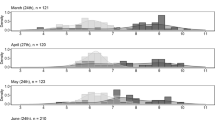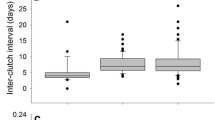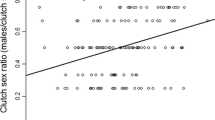Abstract
Among invertebrates, scorpions possess a relatively unique set of reproductive traits. The interrelationships of these traits may have important implications for life history theory, yet there have been few studies of these traits in scorpions. Our data indicate that larger female Centruroides vittatus produce more offspring and have a higher total litter mass than smaller females. There was, however, no significant relationship between offspring size and female or litter size. Mean offspring mass increased with increases in total litter mass and within litter variation in offspring size (coefficients of variation) decreased with increasing total litter mass. These results suggest that large female scorpions with a larger investment in reproduction produced more offspring that were more uniform in size, but not significantly larger, than small females with less investment. The fractional clutch principle and physiological and functional constraints on size and number of offspring are suggested as possible explanations for the relationships we found among offspring size, variation in offspring size and total investment in offspring in C. vittatus.
Similar content being viewed by others
References
Bell G (1980) The costs of reproduction and their consequences. Am Nat 116:45–76
Bell G, Koufopanou V (1986) The cost of reproduction. In: Dawkins R, Ridley M (editors)Oxford Surveys in Evolutionary Biology, vol. 3. Oxford University Press, Oxford, pp 83–131
Bradley RA (1984) The influence of the quantity of food on fecundity in the desert grassland scorpion (Paruroctonus utahensis) (Scorpionida, Vaejovidae): an experimental test. Oecologia 62:53–56
Brockelman WY (1975) Competition, the fitness of offspring and optimal clutch size. Am Nat 109:677–699
Brodie ED III, Ducey PK (1989) Allocation of reproductive investment in the redbelly snake Storeria occipitomaculata. Am Midl Nat 122:51–58
Calow P (1983) Energetics of reproduction and its evolutionary implications. Biol J Linn Soc 20: 153–165
Capinera JL (1979) Qualitative variation in plants and insects; effects of propagule size on ecological plasticity. Am Nat 114:350–361
Crump ML (1981) Variation in propagule size as a function of environmental uncertainty for tree frogs. Am Nat 117:724–737
Crump ML (1984) Intraclutch egg size variability in Hyla crucifer (Anura: Hylidae). Copeia 1984:302–308
Endler JA (1986) Natural selection in the wild. Princeton University Press, Princeton, NJ
Francke OF (1981) Birth behavior and life history of Diplocentrus spitzeri Stahnke (Scorpiones: Diplocentridae). Southwest Nat 25:517–523
Godfray HCJ (1991) The evolution of clutch size in invertebrates. Dawkins R, Ridley M (eds) In: Oxford Surveys in Evolutionary Biology, (eds), vol. 4, Oxford University Press, Oxford, pp. 177–154
Godfray HCJ, Parker GA (1991) Clutch size, fecundity and parent-offspring conflict. In: Harvey PH, Partridge L, Southwood TRE The evolution of reproductive strategies, (eds). Proceedings of the Royal Society, London pp
Kaplan RH, Cooper WE (1984) The evolution of developmental plasticity in reproductive characters: an application of the “adptive coin-flipping” principle. Am Nat 123:393–410
Lack D (1947) The significance of clutch size. Ibis 89:309–352
Lack D (1954) The natural regulation of animal numbers. Oxford University Press, Oxford, UK
Lloyd DG (1987) Selection of offspring size at independence and other size-versus-number strategies. Am Nat 129:800–817
McGinley MA, Temme DH, Geber MA (1987) Parental investment in offspring in variable environments: theoretical and empirical considerations. Am Nat 130:370–398
Nussbaum RA (1981) Seasonal shifts in clutch size and egg size in the side-blotched lizard, Uta stansburiana Baird and Girard. Oecologia 49:14–20
Packard GC, Boardman TJ (1987) The misuse of ratios to scale physiological data that vary allometrically with body size. In: New Directions in Ecological Physiology, Feder ME, Bennett AF, Burggren WW, Huey RH (eds.) Cambridge University Press, Cambridge pp. 216–240
Partridge L, Harvey P (1985) Costs of reproduction. Nature 316:20–21
Partridge L, Harvey P (1988) The ecological context of life history evolution. Science 241:1449–1455
Polis GA (1981) The evolution and dynamics of intraspecific predation. Ann Rev Ecol Syst 12:225–251
Polis GA (1983) Intraspecific predation and “infant killing” among invertebrates. In: Infanticide: an Evolutionary Perspective, Hausfater G, Hrdy SB (eds.), University of Ohio Press, Columbus, Ohio pp. 87–104
Polis GA, Sissom WD (1990) Life history. In: Polis GA (ed.) The Biology of Scorpions, Stanford University Press, Stanford, California, pp. 161–223
Reznick DN (1985) Costs of reproduction: an evaluation of the empirical evidence. Oikos 44:257–267
Rice WR (1989) Analyzing tables of statistical tests. Evolution 43:223–225
Ricklefs RE (1968) On the limitation of brood size in passerine birds by the ability of adults to nourish their young. Proc Natl Acad Sci USA 61:847–851
Shine R, Greer AE (1991) Why are clutch sizes more variable in some species than in others? Evolution 45:1696–1706
Siegel S, Castellan NJ, Jr (1988) Nonparametric statistics for the behavioral sciences. McGraw-Hill Book Company, New York
Sinervo B, Licht L (1991) Proximate constraints on the evolution of egg size, number, and total clutch mass in lizards. Science 252:1300–1302
Smith CC, Fretwell SD (1974) The optimal balance between size and number of offspring. Am Nat 108:499–506
Stamp NE (1980) Egg deposition patterns in butterflies: why do some species cluster their eggs rather than deposit them singly. Am Nat 115:367–380
Stearns SC (1976) Life-history tactics: a review of the ideas. Quart Rev Biol 51:3–47
Stearns SC (1977) The evolution of life-history tactics. Ann Rev Ecol Syst 8: 145–171
Stearns SC (1980) A new view of life-history evolution. Oikos 35:266–281
Stearns SC (1989) Trade-offs in life-history evolution. Func Ecol 3:259–268
Wilbur HM (1977) Propagule size number, and dispersion pattern in Ambystoma and Asclepias. Am Nat 111:43–68
Wilkinson L (1987) SYSTAT: The systems for statistics. SYSTAT INC., Evanston, Illinois
Author information
Authors and Affiliations
Rights and permissions
About this article
Cite this article
Formanowicz, D.R., Shaffer, L.R. Reproductive investiment in the scorpion Centruroides vittatus . Oecologia 94, 368–372 (1993). https://doi.org/10.1007/BF00317111
Received:
Accepted:
Issue Date:
DOI: https://doi.org/10.1007/BF00317111




